Discrimination Against Elderly People: Legislation and Case Law
VerifiedAdded on 2023/01/09
|7
|1928
|96
Report
AI Summary
This report delves into the multifaceted issue of discrimination against elderly people, examining the social groups affected and the areas where discrimination is most prevalent, including age and health. The report identifies and discusses relevant legislation, such as the "Protecting Older Workers Against Discrimination Act" and the Equality Act 2010, highlighting how these laws aim to protect elderly individuals in the workplace and healthcare settings. Furthermore, the report analyzes key case laws, including examples of indirect discrimination, healthcare age discrimination, and discrimination related to pay and redundancy, to illustrate how legal decisions are made in such cases. The conclusion emphasizes the ongoing need for legal protections and effective implementation to combat age-related discrimination across various sectors. The report uses academic journals and books to support the arguments made.
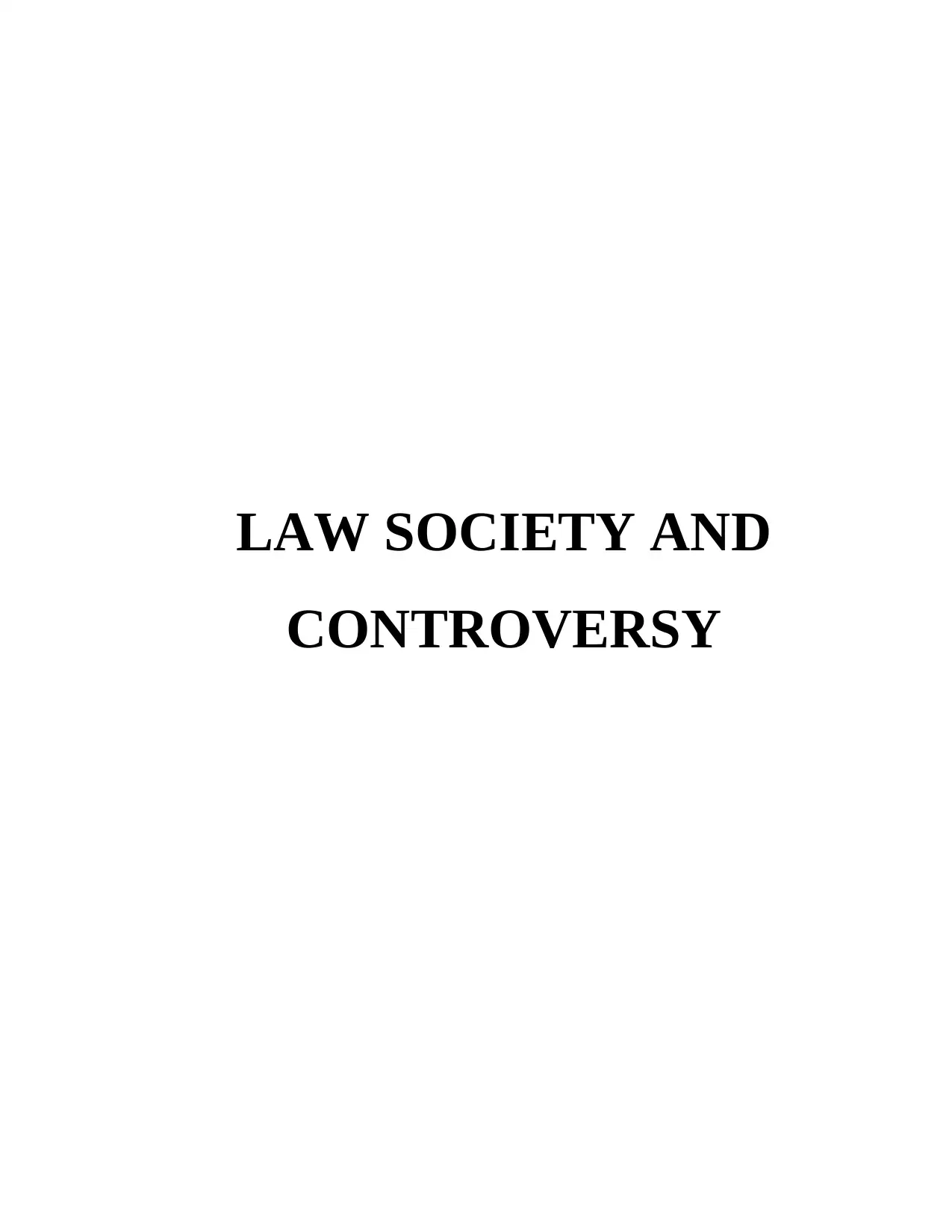
LAW SOCIETY AND
CONTROVERSY
CONTROVERSY
Paraphrase This Document
Need a fresh take? Get an instant paraphrase of this document with our AI Paraphraser
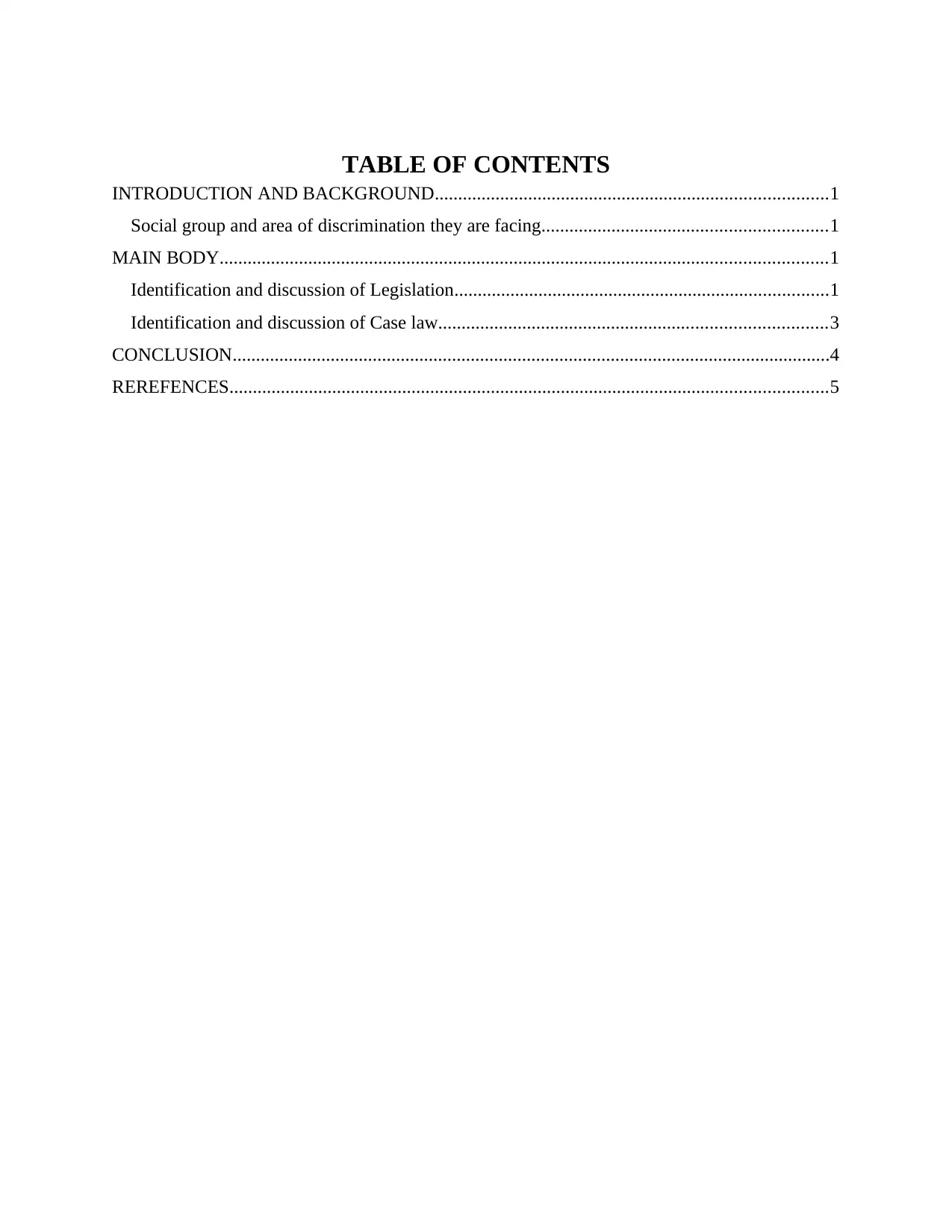
TABLE OF CONTENTS
INTRODUCTION AND BACKGROUND....................................................................................1
Social group and area of discrimination they are facing.............................................................1
MAIN BODY..................................................................................................................................1
Identification and discussion of Legislation................................................................................1
Identification and discussion of Case law...................................................................................3
CONCLUSION................................................................................................................................4
REREFENCES................................................................................................................................5
INTRODUCTION AND BACKGROUND....................................................................................1
Social group and area of discrimination they are facing.............................................................1
MAIN BODY..................................................................................................................................1
Identification and discussion of Legislation................................................................................1
Identification and discussion of Case law...................................................................................3
CONCLUSION................................................................................................................................4
REREFENCES................................................................................................................................5
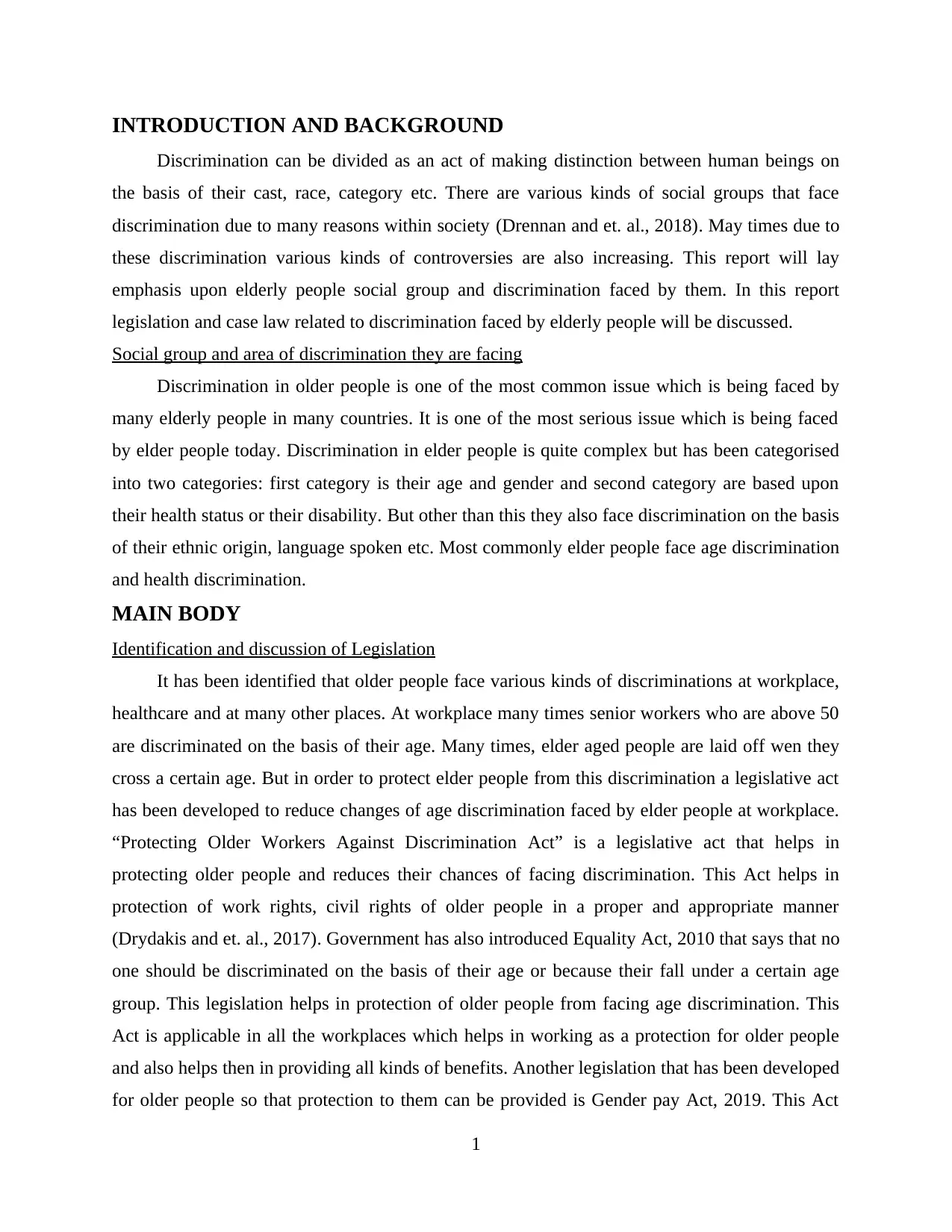
INTRODUCTION AND BACKGROUND
Discrimination can be divided as an act of making distinction between human beings on
the basis of their cast, race, category etc. There are various kinds of social groups that face
discrimination due to many reasons within society (Drennan and et. al., 2018). May times due to
these discrimination various kinds of controversies are also increasing. This report will lay
emphasis upon elderly people social group and discrimination faced by them. In this report
legislation and case law related to discrimination faced by elderly people will be discussed.
Social group and area of discrimination they are facing
Discrimination in older people is one of the most common issue which is being faced by
many elderly people in many countries. It is one of the most serious issue which is being faced
by elder people today. Discrimination in elder people is quite complex but has been categorised
into two categories: first category is their age and gender and second category are based upon
their health status or their disability. But other than this they also face discrimination on the basis
of their ethnic origin, language spoken etc. Most commonly elder people face age discrimination
and health discrimination.
MAIN BODY
Identification and discussion of Legislation
It has been identified that older people face various kinds of discriminations at workplace,
healthcare and at many other places. At workplace many times senior workers who are above 50
are discriminated on the basis of their age. Many times, elder aged people are laid off wen they
cross a certain age. But in order to protect elder people from this discrimination a legislative act
has been developed to reduce changes of age discrimination faced by elder people at workplace.
“Protecting Older Workers Against Discrimination Act” is a legislative act that helps in
protecting older people and reduces their chances of facing discrimination. This Act helps in
protection of work rights, civil rights of older people in a proper and appropriate manner
(Drydakis and et. al., 2017). Government has also introduced Equality Act, 2010 that says that no
one should be discriminated on the basis of their age or because their fall under a certain age
group. This legislation helps in protection of older people from facing age discrimination. This
Act is applicable in all the workplaces which helps in working as a protection for older people
and also helps then in providing all kinds of benefits. Another legislation that has been developed
for older people so that protection to them can be provided is Gender pay Act, 2019. This Act
1
Discrimination can be divided as an act of making distinction between human beings on
the basis of their cast, race, category etc. There are various kinds of social groups that face
discrimination due to many reasons within society (Drennan and et. al., 2018). May times due to
these discrimination various kinds of controversies are also increasing. This report will lay
emphasis upon elderly people social group and discrimination faced by them. In this report
legislation and case law related to discrimination faced by elderly people will be discussed.
Social group and area of discrimination they are facing
Discrimination in older people is one of the most common issue which is being faced by
many elderly people in many countries. It is one of the most serious issue which is being faced
by elder people today. Discrimination in elder people is quite complex but has been categorised
into two categories: first category is their age and gender and second category are based upon
their health status or their disability. But other than this they also face discrimination on the basis
of their ethnic origin, language spoken etc. Most commonly elder people face age discrimination
and health discrimination.
MAIN BODY
Identification and discussion of Legislation
It has been identified that older people face various kinds of discriminations at workplace,
healthcare and at many other places. At workplace many times senior workers who are above 50
are discriminated on the basis of their age. Many times, elder aged people are laid off wen they
cross a certain age. But in order to protect elder people from this discrimination a legislative act
has been developed to reduce changes of age discrimination faced by elder people at workplace.
“Protecting Older Workers Against Discrimination Act” is a legislative act that helps in
protecting older people and reduces their chances of facing discrimination. This Act helps in
protection of work rights, civil rights of older people in a proper and appropriate manner
(Drydakis and et. al., 2017). Government has also introduced Equality Act, 2010 that says that no
one should be discriminated on the basis of their age or because their fall under a certain age
group. This legislation helps in protection of older people from facing age discrimination. This
Act is applicable in all the workplaces which helps in working as a protection for older people
and also helps then in providing all kinds of benefits. Another legislation that has been developed
for older people so that protection to them can be provided is Gender pay Act, 2019. This Act
1
⊘ This is a preview!⊘
Do you want full access?
Subscribe today to unlock all pages.

Trusted by 1+ million students worldwide
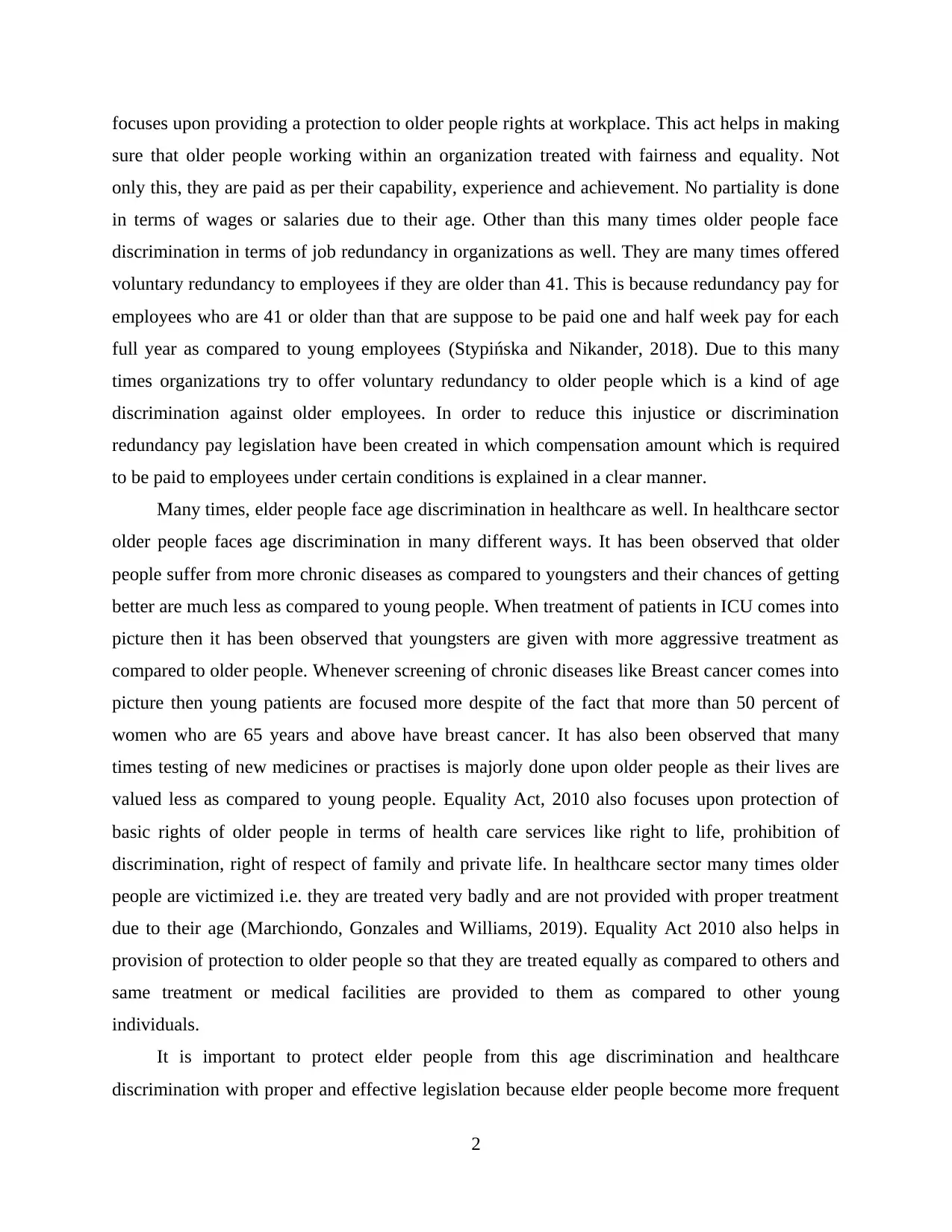
focuses upon providing a protection to older people rights at workplace. This act helps in making
sure that older people working within an organization treated with fairness and equality. Not
only this, they are paid as per their capability, experience and achievement. No partiality is done
in terms of wages or salaries due to their age. Other than this many times older people face
discrimination in terms of job redundancy in organizations as well. They are many times offered
voluntary redundancy to employees if they are older than 41. This is because redundancy pay for
employees who are 41 or older than that are suppose to be paid one and half week pay for each
full year as compared to young employees (Stypińska and Nikander, 2018). Due to this many
times organizations try to offer voluntary redundancy to older people which is a kind of age
discrimination against older employees. In order to reduce this injustice or discrimination
redundancy pay legislation have been created in which compensation amount which is required
to be paid to employees under certain conditions is explained in a clear manner.
Many times, elder people face age discrimination in healthcare as well. In healthcare sector
older people faces age discrimination in many different ways. It has been observed that older
people suffer from more chronic diseases as compared to youngsters and their chances of getting
better are much less as compared to young people. When treatment of patients in ICU comes into
picture then it has been observed that youngsters are given with more aggressive treatment as
compared to older people. Whenever screening of chronic diseases like Breast cancer comes into
picture then young patients are focused more despite of the fact that more than 50 percent of
women who are 65 years and above have breast cancer. It has also been observed that many
times testing of new medicines or practises is majorly done upon older people as their lives are
valued less as compared to young people. Equality Act, 2010 also focuses upon protection of
basic rights of older people in terms of health care services like right to life, prohibition of
discrimination, right of respect of family and private life. In healthcare sector many times older
people are victimized i.e. they are treated very badly and are not provided with proper treatment
due to their age (Marchiondo, Gonzales and Williams, 2019). Equality Act 2010 also helps in
provision of protection to older people so that they are treated equally as compared to others and
same treatment or medical facilities are provided to them as compared to other young
individuals.
It is important to protect elder people from this age discrimination and healthcare
discrimination with proper and effective legislation because elder people become more frequent
2
sure that older people working within an organization treated with fairness and equality. Not
only this, they are paid as per their capability, experience and achievement. No partiality is done
in terms of wages or salaries due to their age. Other than this many times older people face
discrimination in terms of job redundancy in organizations as well. They are many times offered
voluntary redundancy to employees if they are older than 41. This is because redundancy pay for
employees who are 41 or older than that are suppose to be paid one and half week pay for each
full year as compared to young employees (Stypińska and Nikander, 2018). Due to this many
times organizations try to offer voluntary redundancy to older people which is a kind of age
discrimination against older employees. In order to reduce this injustice or discrimination
redundancy pay legislation have been created in which compensation amount which is required
to be paid to employees under certain conditions is explained in a clear manner.
Many times, elder people face age discrimination in healthcare as well. In healthcare sector
older people faces age discrimination in many different ways. It has been observed that older
people suffer from more chronic diseases as compared to youngsters and their chances of getting
better are much less as compared to young people. When treatment of patients in ICU comes into
picture then it has been observed that youngsters are given with more aggressive treatment as
compared to older people. Whenever screening of chronic diseases like Breast cancer comes into
picture then young patients are focused more despite of the fact that more than 50 percent of
women who are 65 years and above have breast cancer. It has also been observed that many
times testing of new medicines or practises is majorly done upon older people as their lives are
valued less as compared to young people. Equality Act, 2010 also focuses upon protection of
basic rights of older people in terms of health care services like right to life, prohibition of
discrimination, right of respect of family and private life. In healthcare sector many times older
people are victimized i.e. they are treated very badly and are not provided with proper treatment
due to their age (Marchiondo, Gonzales and Williams, 2019). Equality Act 2010 also helps in
provision of protection to older people so that they are treated equally as compared to others and
same treatment or medical facilities are provided to them as compared to other young
individuals.
It is important to protect elder people from this age discrimination and healthcare
discrimination with proper and effective legislation because elder people become more frequent
2
Paraphrase This Document
Need a fresh take? Get an instant paraphrase of this document with our AI Paraphraser
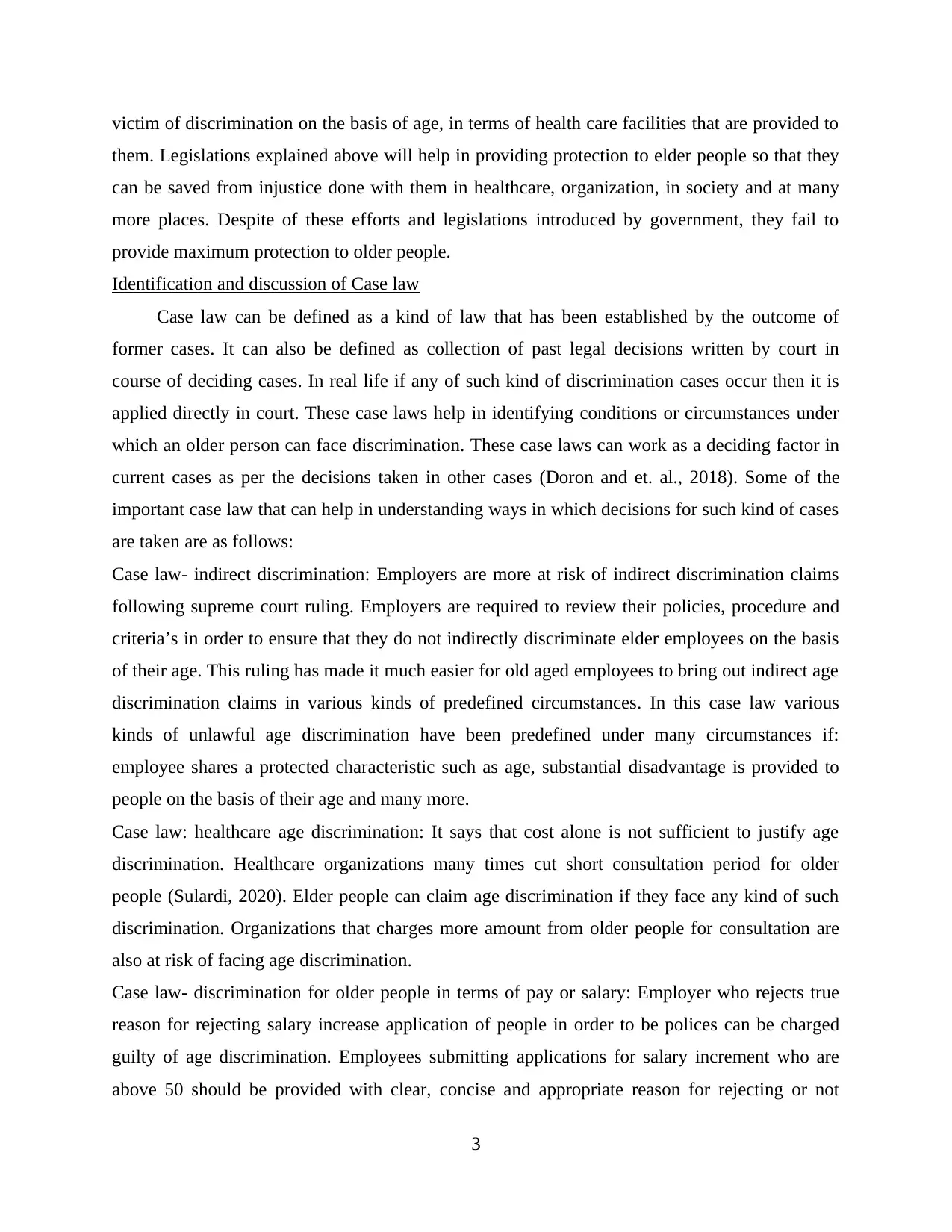
victim of discrimination on the basis of age, in terms of health care facilities that are provided to
them. Legislations explained above will help in providing protection to elder people so that they
can be saved from injustice done with them in healthcare, organization, in society and at many
more places. Despite of these efforts and legislations introduced by government, they fail to
provide maximum protection to older people.
Identification and discussion of Case law
Case law can be defined as a kind of law that has been established by the outcome of
former cases. It can also be defined as collection of past legal decisions written by court in
course of deciding cases. In real life if any of such kind of discrimination cases occur then it is
applied directly in court. These case laws help in identifying conditions or circumstances under
which an older person can face discrimination. These case laws can work as a deciding factor in
current cases as per the decisions taken in other cases (Doron and et. al., 2018). Some of the
important case law that can help in understanding ways in which decisions for such kind of cases
are taken are as follows:
Case law- indirect discrimination: Employers are more at risk of indirect discrimination claims
following supreme court ruling. Employers are required to review their policies, procedure and
criteria’s in order to ensure that they do not indirectly discriminate elder employees on the basis
of their age. This ruling has made it much easier for old aged employees to bring out indirect age
discrimination claims in various kinds of predefined circumstances. In this case law various
kinds of unlawful age discrimination have been predefined under many circumstances if:
employee shares a protected characteristic such as age, substantial disadvantage is provided to
people on the basis of their age and many more.
Case law: healthcare age discrimination: It says that cost alone is not sufficient to justify age
discrimination. Healthcare organizations many times cut short consultation period for older
people (Sulardi, 2020). Elder people can claim age discrimination if they face any kind of such
discrimination. Organizations that charges more amount from older people for consultation are
also at risk of facing age discrimination.
Case law- discrimination for older people in terms of pay or salary: Employer who rejects true
reason for rejecting salary increase application of people in order to be polices can be charged
guilty of age discrimination. Employees submitting applications for salary increment who are
above 50 should be provided with clear, concise and appropriate reason for rejecting or not
3
them. Legislations explained above will help in providing protection to elder people so that they
can be saved from injustice done with them in healthcare, organization, in society and at many
more places. Despite of these efforts and legislations introduced by government, they fail to
provide maximum protection to older people.
Identification and discussion of Case law
Case law can be defined as a kind of law that has been established by the outcome of
former cases. It can also be defined as collection of past legal decisions written by court in
course of deciding cases. In real life if any of such kind of discrimination cases occur then it is
applied directly in court. These case laws help in identifying conditions or circumstances under
which an older person can face discrimination. These case laws can work as a deciding factor in
current cases as per the decisions taken in other cases (Doron and et. al., 2018). Some of the
important case law that can help in understanding ways in which decisions for such kind of cases
are taken are as follows:
Case law- indirect discrimination: Employers are more at risk of indirect discrimination claims
following supreme court ruling. Employers are required to review their policies, procedure and
criteria’s in order to ensure that they do not indirectly discriminate elder employees on the basis
of their age. This ruling has made it much easier for old aged employees to bring out indirect age
discrimination claims in various kinds of predefined circumstances. In this case law various
kinds of unlawful age discrimination have been predefined under many circumstances if:
employee shares a protected characteristic such as age, substantial disadvantage is provided to
people on the basis of their age and many more.
Case law: healthcare age discrimination: It says that cost alone is not sufficient to justify age
discrimination. Healthcare organizations many times cut short consultation period for older
people (Sulardi, 2020). Elder people can claim age discrimination if they face any kind of such
discrimination. Organizations that charges more amount from older people for consultation are
also at risk of facing age discrimination.
Case law- discrimination for older people in terms of pay or salary: Employer who rejects true
reason for rejecting salary increase application of people in order to be polices can be charged
guilty of age discrimination. Employees submitting applications for salary increment who are
above 50 should be provided with clear, concise and appropriate reason for rejecting or not
3
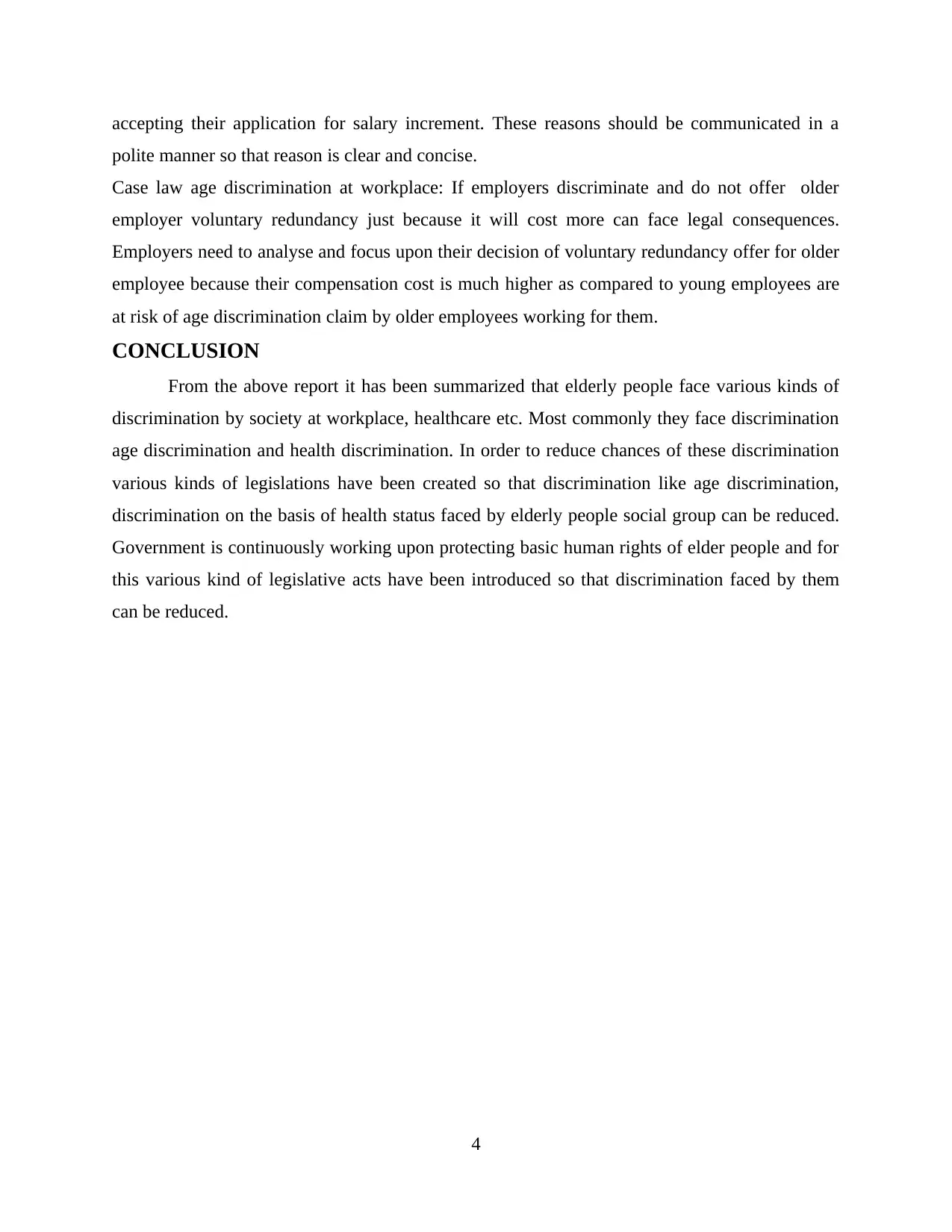
accepting their application for salary increment. These reasons should be communicated in a
polite manner so that reason is clear and concise.
Case law age discrimination at workplace: If employers discriminate and do not offer older
employer voluntary redundancy just because it will cost more can face legal consequences.
Employers need to analyse and focus upon their decision of voluntary redundancy offer for older
employee because their compensation cost is much higher as compared to young employees are
at risk of age discrimination claim by older employees working for them.
CONCLUSION
From the above report it has been summarized that elderly people face various kinds of
discrimination by society at workplace, healthcare etc. Most commonly they face discrimination
age discrimination and health discrimination. In order to reduce chances of these discrimination
various kinds of legislations have been created so that discrimination like age discrimination,
discrimination on the basis of health status faced by elderly people social group can be reduced.
Government is continuously working upon protecting basic human rights of elder people and for
this various kind of legislative acts have been introduced so that discrimination faced by them
can be reduced.
4
polite manner so that reason is clear and concise.
Case law age discrimination at workplace: If employers discriminate and do not offer older
employer voluntary redundancy just because it will cost more can face legal consequences.
Employers need to analyse and focus upon their decision of voluntary redundancy offer for older
employee because their compensation cost is much higher as compared to young employees are
at risk of age discrimination claim by older employees working for them.
CONCLUSION
From the above report it has been summarized that elderly people face various kinds of
discrimination by society at workplace, healthcare etc. Most commonly they face discrimination
age discrimination and health discrimination. In order to reduce chances of these discrimination
various kinds of legislations have been created so that discrimination like age discrimination,
discrimination on the basis of health status faced by elderly people social group can be reduced.
Government is continuously working upon protecting basic human rights of elder people and for
this various kind of legislative acts have been introduced so that discrimination faced by them
can be reduced.
4
⊘ This is a preview!⊘
Do you want full access?
Subscribe today to unlock all pages.

Trusted by 1+ million students worldwide
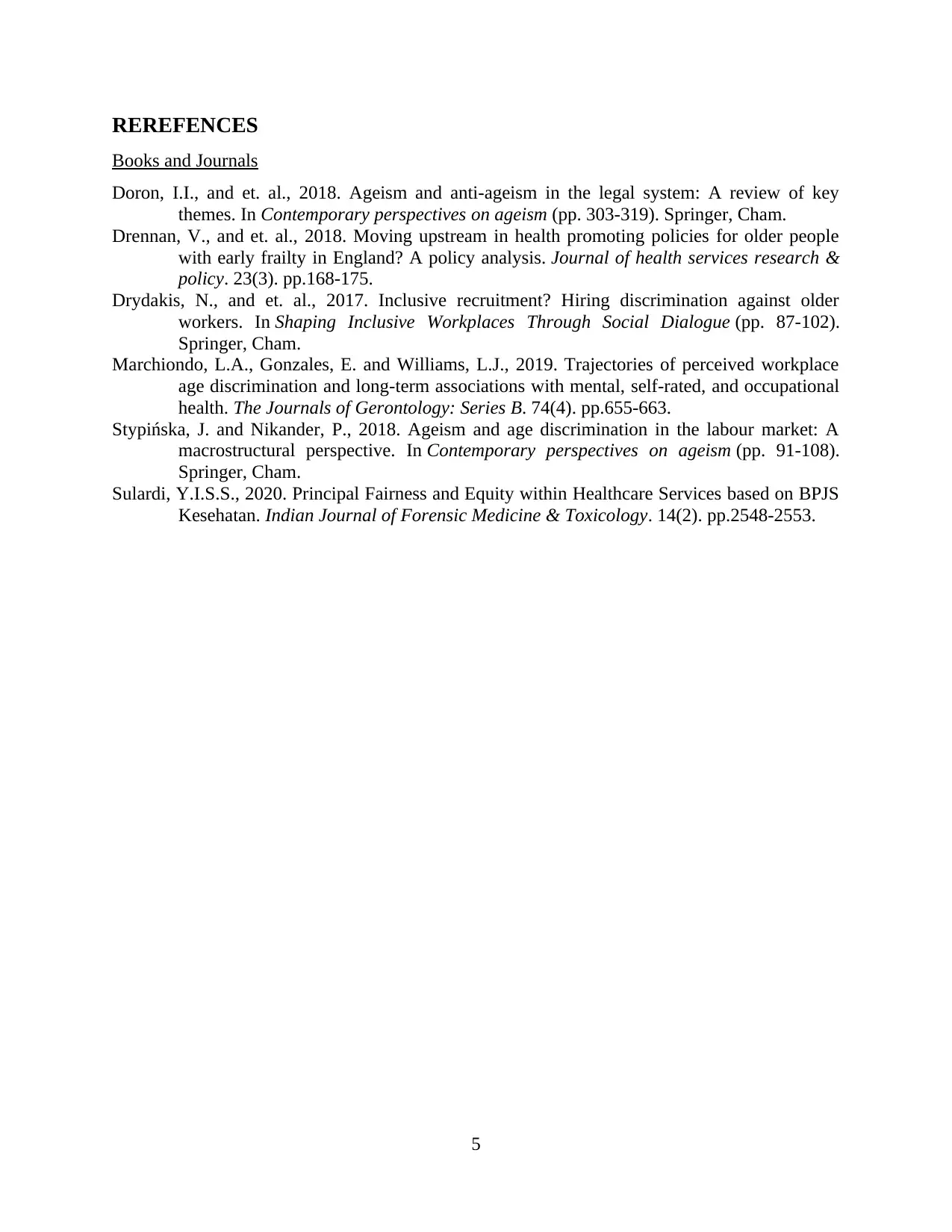
REREFENCES
Books and Journals
Doron, I.I., and et. al., 2018. Ageism and anti-ageism in the legal system: A review of key
themes. In Contemporary perspectives on ageism (pp. 303-319). Springer, Cham.
Drennan, V., and et. al., 2018. Moving upstream in health promoting policies for older people
with early frailty in England? A policy analysis. Journal of health services research &
policy. 23(3). pp.168-175.
Drydakis, N., and et. al., 2017. Inclusive recruitment? Hiring discrimination against older
workers. In Shaping Inclusive Workplaces Through Social Dialogue (pp. 87-102).
Springer, Cham.
Marchiondo, L.A., Gonzales, E. and Williams, L.J., 2019. Trajectories of perceived workplace
age discrimination and long-term associations with mental, self-rated, and occupational
health. The Journals of Gerontology: Series B. 74(4). pp.655-663.
Stypińska, J. and Nikander, P., 2018. Ageism and age discrimination in the labour market: A
macrostructural perspective. In Contemporary perspectives on ageism (pp. 91-108).
Springer, Cham.
Sulardi, Y.I.S.S., 2020. Principal Fairness and Equity within Healthcare Services based on BPJS
Kesehatan. Indian Journal of Forensic Medicine & Toxicology. 14(2). pp.2548-2553.
5
Books and Journals
Doron, I.I., and et. al., 2018. Ageism and anti-ageism in the legal system: A review of key
themes. In Contemporary perspectives on ageism (pp. 303-319). Springer, Cham.
Drennan, V., and et. al., 2018. Moving upstream in health promoting policies for older people
with early frailty in England? A policy analysis. Journal of health services research &
policy. 23(3). pp.168-175.
Drydakis, N., and et. al., 2017. Inclusive recruitment? Hiring discrimination against older
workers. In Shaping Inclusive Workplaces Through Social Dialogue (pp. 87-102).
Springer, Cham.
Marchiondo, L.A., Gonzales, E. and Williams, L.J., 2019. Trajectories of perceived workplace
age discrimination and long-term associations with mental, self-rated, and occupational
health. The Journals of Gerontology: Series B. 74(4). pp.655-663.
Stypińska, J. and Nikander, P., 2018. Ageism and age discrimination in the labour market: A
macrostructural perspective. In Contemporary perspectives on ageism (pp. 91-108).
Springer, Cham.
Sulardi, Y.I.S.S., 2020. Principal Fairness and Equity within Healthcare Services based on BPJS
Kesehatan. Indian Journal of Forensic Medicine & Toxicology. 14(2). pp.2548-2553.
5
1 out of 7
Related Documents
Your All-in-One AI-Powered Toolkit for Academic Success.
+13062052269
info@desklib.com
Available 24*7 on WhatsApp / Email
![[object Object]](/_next/static/media/star-bottom.7253800d.svg)
Unlock your academic potential
Copyright © 2020–2025 A2Z Services. All Rights Reserved. Developed and managed by ZUCOL.
![Issues and Laws: Protecting the Aged in Australia - [University Name]](/_next/image/?url=https%3A%2F%2Fdesklib.com%2Fmedia%2Fimages%2Fds%2Fbcb4fe90bf704423a050f4e10fe3b7cc.jpg&w=256&q=75)




